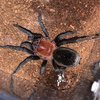Hello all. I am very new to keeping spiders and I had several questions. I have kept lots of other animals and I know that their needs are the top priority. I am looking for a tarantula for a specific type of enclosure I want to build. I want to stress that it is not built yet, and I will make all the accommodations necessary for their happiness and well-being. I am trying to figure out which type best fits the enclosure I want to build so the modifications necessary are minimal, yet the animal is well cared for. I want to build a forest type enclosure with live plants and moss. I will utilize cork bark for the background and also use it to build climbing structures, hides, etc. I also plan on utilizing wood branches for a more natural look. I will also add springtails but I will not add isopods. For substrate I will be using either ABG or Terra Aranea and I will utilize leaf litter. I am looking at several enclosures and I can go as big as a 5.5 gallon tank but the 2 I would like to use have dimensions of either 12 x 8 x 10 inches or 10.5 x 10 x 14.5 inches. All of the enclosures will be vented however there will be high humidity present. I am looking for suggestions on what I can keep in the above enclosure setup and yet that also aligns with the following:
Small- ideally less than 2"
I do not want one that webs a lot. I know that their care contributes to more or less webbing (temperature, humidity, etc.) but are there species that are known to not web up the enclosure?
Based on research so far it is looking like an arboreal type is not ideal as I read that they like to web up their enclosures a lot but if there is a species that does not web a lot I would be interested
Mild venom for just in case I get bitten. I do not plan on handling unless absolutely necessary but the plants will require occasional trimming so I will need to get in the enclosure
I do not expect it to be outside its burrow all the time, but I do not want a pet hole
Beginner friendly
Ideally it can housed at room temperature but a heating pad or ceramic heater can be utilized if necessary
Are there any tarantulas that fit the above criteria? I am also looking at wolf spiders, primarily the Honga family. Any suggestions you can give are greatly appreciated.
Small- ideally less than 2"
I do not want one that webs a lot. I know that their care contributes to more or less webbing (temperature, humidity, etc.) but are there species that are known to not web up the enclosure?
Based on research so far it is looking like an arboreal type is not ideal as I read that they like to web up their enclosures a lot but if there is a species that does not web a lot I would be interested
Mild venom for just in case I get bitten. I do not plan on handling unless absolutely necessary but the plants will require occasional trimming so I will need to get in the enclosure
I do not expect it to be outside its burrow all the time, but I do not want a pet hole
Beginner friendly
Ideally it can housed at room temperature but a heating pad or ceramic heater can be utilized if necessary
Are there any tarantulas that fit the above criteria? I am also looking at wolf spiders, primarily the Honga family. Any suggestions you can give are greatly appreciated.

